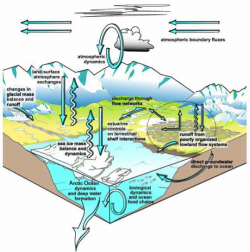The Freshwater Integration Effort (FWI) was an Arctic System Science (ARCSS)-funded interdisciplinary program focused on the arctic hydrological cycle. FWI consisted of 22 projects, which ran from 2002-2006, on all aspects of the arctic freshwater system. The program is now undertaking final synthesis activities.

Freshwater cycle changes are important to understand for a number of reasons. Warming and freshwater cycle intensification have the potential to increase shrub growth and cause other vegetation changes. There are also strong linkages between water and carbon cycles; for example, methane fluxes from the landscape are closely linked with variations in the water table, which, in turn, are linked with rates of precipitation and evapotranspiration. In addition, there are connections between freshening of polar oceans and alterations to the global thermohaline circulation. Finally, continuing declines in sea ice may affect the freshwater cycle even further.
Using models and observational data, the working group compared trends in freshwater fluxes across the terrestrial pan-arctic drainage basin and the Arctic Ocean over the past several decades. Trends from coupled models provided benchmarks for future changes. The group examined terrestrial fluxes of precipitation, evapotranspiration, and river discharge averaged over the pan-arctic basin from a variety of observed data sets. For the Arctic Ocean and surrounding seas, freshwater (both liquid ocean and solid sea ice) storage and fluxes at inflow and outflow boundaries were examined from available data sources and recent publications. In addition to the observational data, trends were also determined from nine atmosphere-ocean general circulation models from the Intergovernmental Panel on Climate Change's (IPCC) Coupled Model Intercomparison Project, Phase 3 (CMIP3).
While uncertainties due to the sparse nature of observing networks and the considerable variability in the system complicate any interpretation of freshwater cycle changes, the predominance of positive trends over recent decades suggests that the freshwater system is intensifying.
For the terrestrial system, of 19 observed time series examined, 17 showed a positive trend (nine significant). The CMIP3 data also show positive trends in precipitation (P), evapotranspiration (E), and P-E, which are on par with the observed trends. Trends in the net freshwater exchange between the Arctic Ocean and more southern seas are inconclusive, largely due to a lack of available data over recent decades. For the terrestrial system, recent data suggest that river discharge may be increasing across much of the arctic drainage basin in North America. Taken together with the reported positive trend from large Eurasian rivers, this suggests that intensification of river discharge may now be pan-arctic in nature.
Results from this study will be published in the November 2010 Journal of Climate.
For more information, contact Michael Rawlins (rawlins [at] geo.umass.edu).
FWI Working Groups and Select Publications
FWI Synthesis Working Groups and Focus Topics
Budgeteers Working Group – Tasked with answering the following questions:
- What are the major stocks and fluxes?
- Where are the imbalances?
- How well can we close the water budget?
Changes and Attributions Working Groups (CAWG) – Tasked to:
- Summarize observed changes in the arctic hydrological system (CAWG-1).
- Develop a heuristic modeling framework predicting likely changes in the system state into the next century (CAWG-2).
Intensifiers Working Group – Tasked with investigating a potential intensification of the water cycle associated with climate change.
FWI Synthesis Working Group Publications
"The large-scale freshwater cycle of the Arctic" by M.C. Serreze, et al. Published in the Journal of Geophysical Research, 2006. Volume 111.
"An arctic hydrologic system in transition: Feedbacks and impacts on terrestrial, marine, and human life" by J.A. Francis, et al. Published in the Journal of Geophysical Research, 2009. Volume 114.
"Changes and impacts in the arctic freshwater cycle" by D. White, et al. Published in the Journal of Geophysical Research, 2007. Volume 122.
"Analysis of the Arctic System for Freshwater Cycle Intensification: Observations and Expectations" by M.A. Rawlins, et al. Published in the Journal of Climate, 2010. Volume 23.
"Intensifiers" Working Group Members
- Michael A. Rawlins; University of Massachusetts
- Michael Steele, Craig M. Lee, Dennis P. Lettenmaier, Mark Wensnahan, and Rebecca Woodgate; University of Washington
- Marika M. Holland; National Center for Atmospheric Research
- Jennifer C. Adam; Washington State University
- Jessica E. Cherry and Larry D. Hinzman; International Arctic Research Center
- Jennifer A. Francis; Rutgers University
- Pavel Ya. Groisman; National Climatic Data Center
- Thomas G. Huntington; U.S. Geological Survey
- Douglas L. Kane and Daqing Yang; University of Alaska Fairbanks
- John S. Kimball and Ke Zhang; University of Montana
- Ron Kwok, Kyle C. McDonald, and Erika Podest; Jet Propulsion Laboratory
- Richard B. Lammers, Jonathan W. Pundsack, and Alexander Shiklomanov; University of New Hampshire
- Bert Rudels; Finnish Meteorological Institute
- Mark C. Serreze and Tingjun Zhang; National Snow and Ice Data Center
- Oystein Skagseth; Bjerknes Centre for Climate Research
- Tara J. Troy and Eric F. Wood; Princeton University
- Charles J. Vörösmarty; City College of New York
